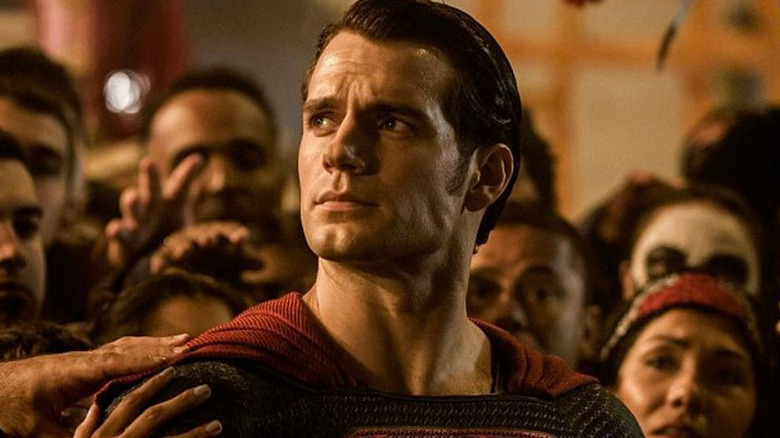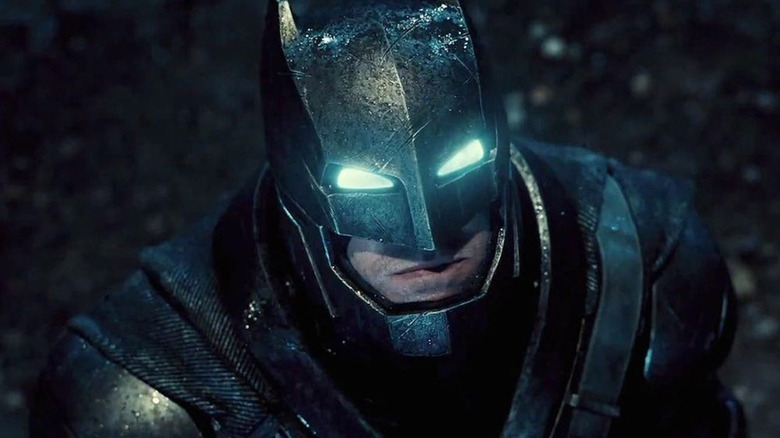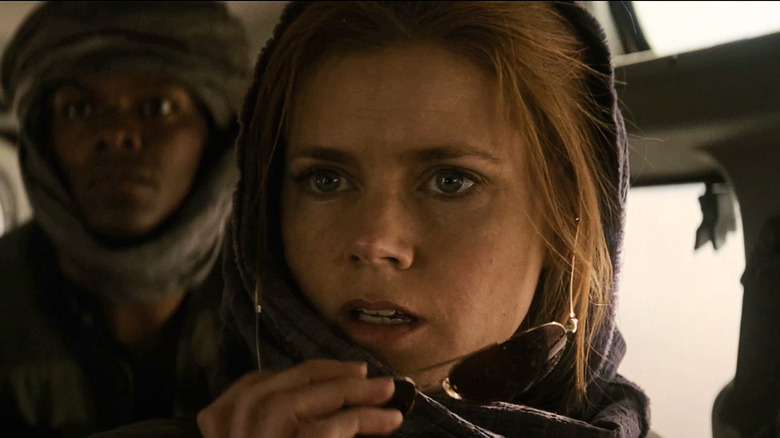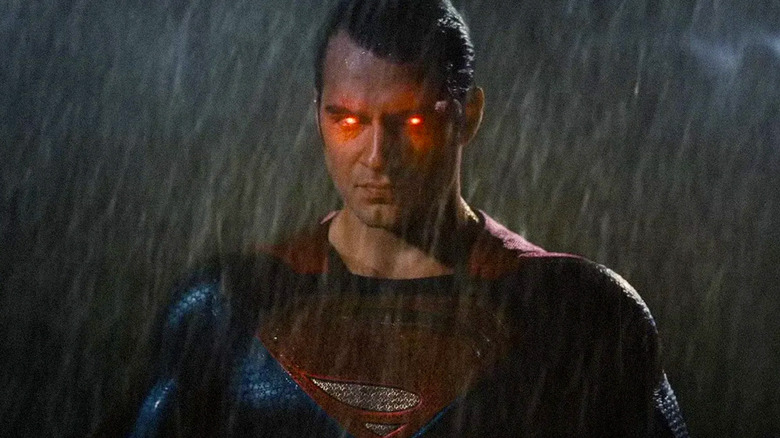The Batman V. Superman Moment That Sparked A Battle Behind The Scenes
The ongoing contention behind Zack Snyder's final DC film, "Justice League," has already become something of a legend. The war between Snyder's original vision and Joss Whedon's eventual remix sparked controversy between fans, the studio, and even the actors — but even before #ReleaseTheSnyderCut first trended, DC's Extended Universe was already on shaky footing.
It all seemed to really start with "Batman v Superman: Dawn of Justice," which preceded the first "Justice League" by only a year. The film introduced key characters like Ben Affleck's Batman, Gal Gadot's Wonder Woman, and Jesse Eisenberg's Lex Luthor, and set the scene for the dawn of Justice League (as the title so deftly suggests). The film was polarizing for a number of reasons, but largely forgettable due to its incoherent story and overreliance on spectacle.
But as we all later learned, director Zack Snyder and his screenwriter, Chris Terrio, had a pretty solid vision for the Snyderverse — one that was bungled by those meddlesome studio execs at Warner Bros. The Snyderverse is a textbook example of the dreaded adage: "Too many cooks spoil the broth." No one knows this better than Terrio, who was hired in the early stages to tweak "Batman v Superman," and who later wrote Snyder's "Justice League." Terrio has a first-hand account of Warner Bros.' messiest practices — and in a recent tell-all with Vanity Fair, he addressed the worst of it.
A Simple Favor
Terrio first joined "Batman v Superman" in an apparent effort to appease Ben Affleck. The two had worked together (as writer and director, respectively) on the Oscar-winning "Argo," and it was Affleck who first asked Terrio to tweak the original script. In the film's first draft, which was penned by "Man of Steel" scribe David S. Goyer, "Batman was going to have gone down a dark road." One of the story's "non-negotiable" elements was the "Bat Brand," which the Dark Knight used throughout the film to "mark" the criminals he'd captured.
"[Affleck] asked if I would do some character work," Terrio told VF. "My job was to create a story and a tone, really, in which Batman could be that person."
A common criticism of "Batman v Superman" was its overly-bleak tone — a burden that Terrio has largely been shouldered with ever since. But Terrio maintains that his writing actually saved the film from going too far. He even made major tweaks to Superman's arc, fleshing out the film's bewildering "Africa" sequence.
Conscience Vs. Perversion
Early in the film, Lois Lane (Amy Adams) travels to Nairomi, a fictional African nation in the midst of a contentious civil war. Lois has scored an exclusive interview with Nairomian warlord Amajagh, but her sit-down is compromised by a CIA operative posing as her photographer. Amajagh naturally takes Lois hostage, but Superman arrives before long to rescue her.
Terrio noted that, in the original first draft, Lois is brutalized by unspecified "Black Muslim African" characters. Lois then threatens the Nairomians, boasting "that Superman is not going to go easy on them because they punched her." Terrio fought hard to rework this sequence in particular, and rightfully so: it falls into the same tired trope that hindered another beloved superhero franchise. However, his "dark sensibilities" were repeatedly called into question:
I wanted to say, "I've been saving you from yourselves! I've been working with the director to bring a voice of conscience and sanity to the almost perversely dark film you've been developing for years, but I'm the problem here?"
The Nairomi sequence became an arena for several topics that Terrio felt were crucial to the film. Terrio was able to nix the punch, and also introduced elements that would force Superman to "grapple" with his unlimited power. Lois' altercation in Nairomi is incidentally a trap set for Superman by Lex Luthor. Terrio's rewrite clearly establishes that Luthor is pulling the strings: it's his hired muscle that kills the men of the Nairomi village and burns their bodies to imitate Superman's heat vision, effectively framing him for their murders.
Terrio even created Kahina Ziri, a character who survives the skirmish in Nairomi and later testifies against Superman in the Supreme Court. Though it's later revealed that her statement was coerced by Luthor, it still saddles Superman with uncomfortable repercussions.
The Vindication of His Vision
Terrio was sure that Warner Bros. was happy with his final script, but the studio tinkered with "Batman v Superman" once again during post-production. A shocking 30 minutes were cut from the film for the theatrical version. Key elements of the story — including parts of the Nairomi sequence — were dropped to soften the film's 3-hour runtime. The cuts drastically muddled the plot, something that, to Terrio, contributed greatly to its poor reception:
"I was proud of the script when I completed it, but it turns out that when you remove the 30 minutes that give the characters motivation for the climax, the film just doesn't work."
Fortunately, the original cut was restored and released as "The Ultimate Edition" in 2016. Terrio and Snyder's original vision for "Justice League" would undergo similar revision at the hands of Joss Whedon — only for Warner Bros. to release "Zack Snyder's Justice League" on HBO Max four years later. The Snyder Cut, ironically, helped redeem "Batman v Superman" in the eyes of both critics and fans, though not enough to reinstate Snyder as the definitive mind behind most of the DCEU.
It's pretty clear that Terrio's had his fill of franchise films for now. With no Zack Snyder to coax him back to Warner Bros, the Extended Universe has probably lost one of the best writers it had at its disposal. Terrio will be returning to film with a "smaller, character-driven" film at Amazon Studios. After working back-to-back on franchises like DC and later, Star Wars (with "The Rise of Skywalker"), Terrio is eager to take on a story that "reminds myself of why I like to write a film."



